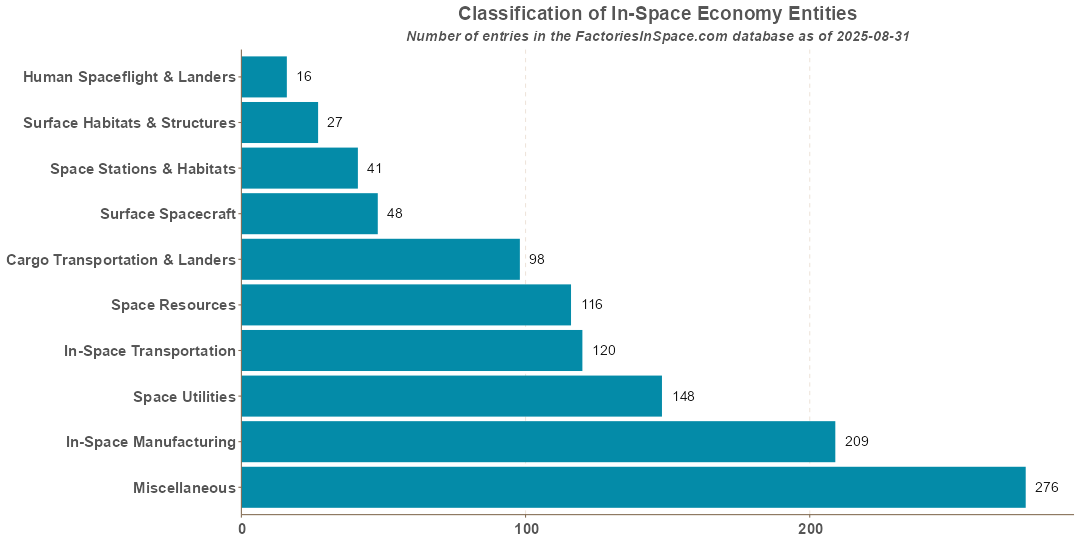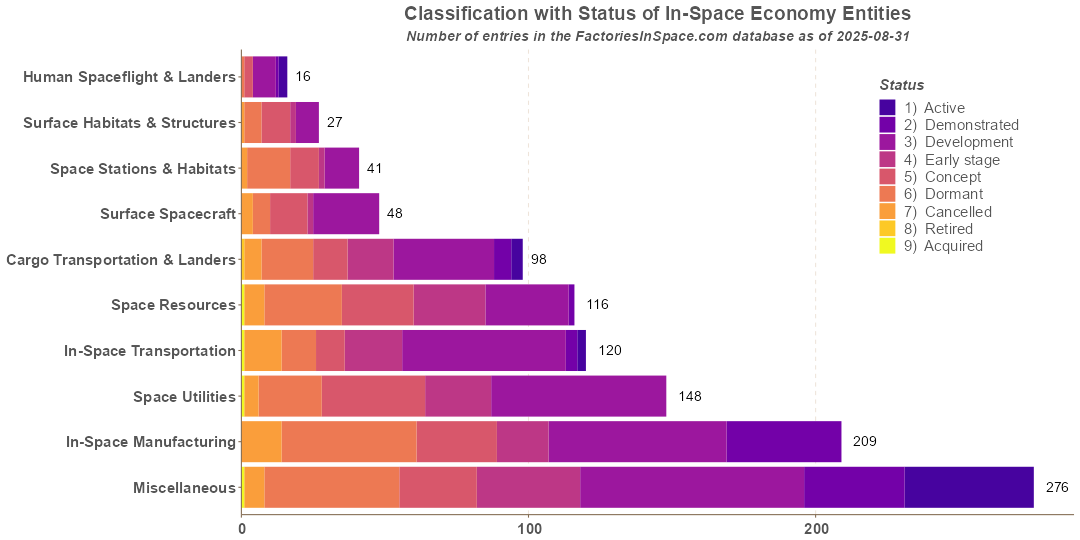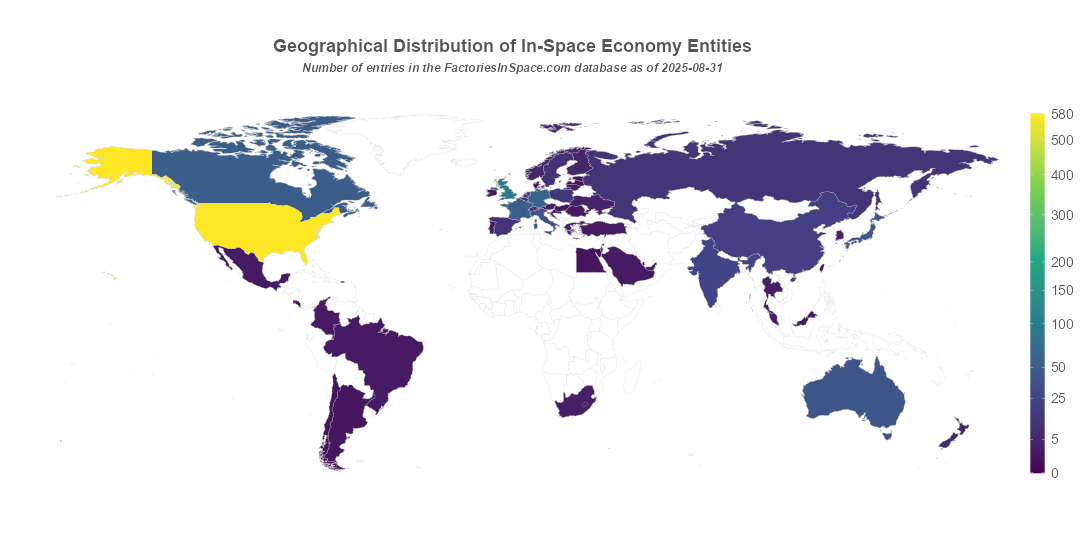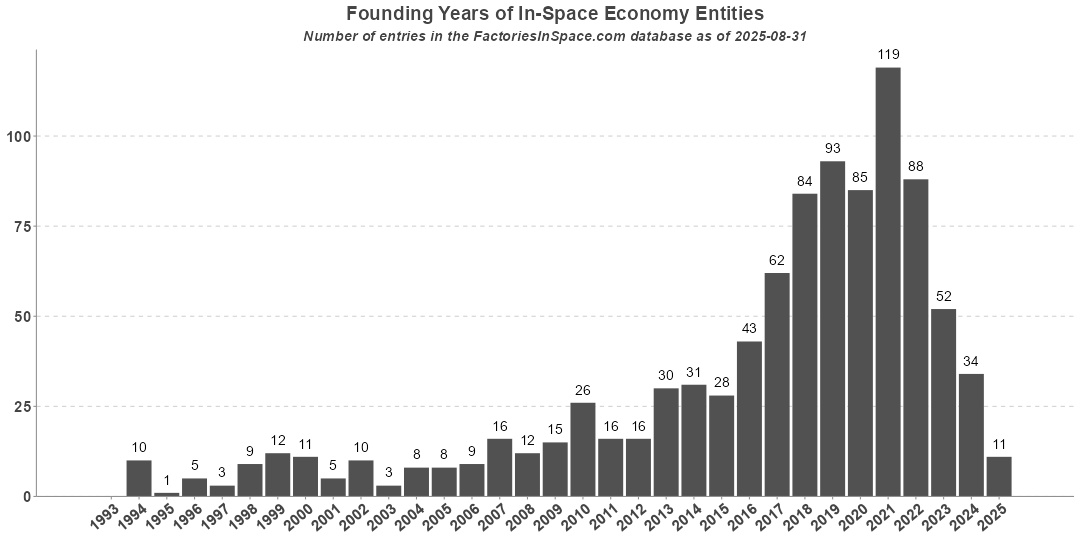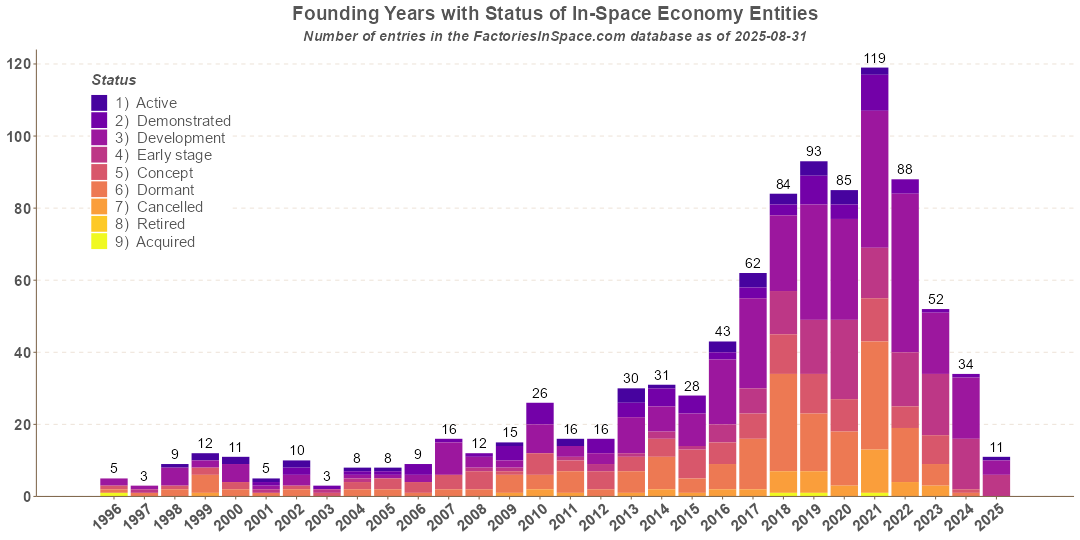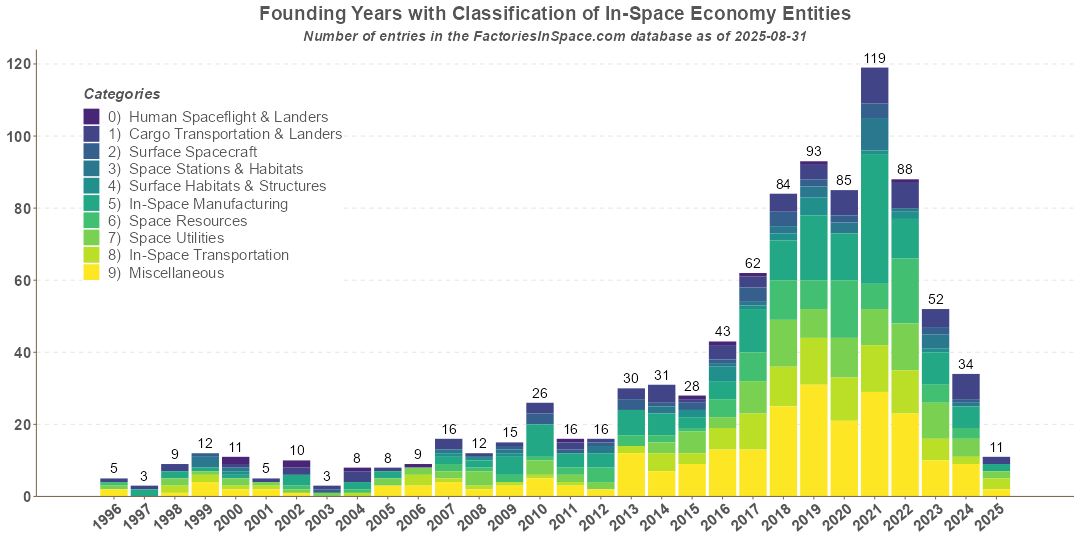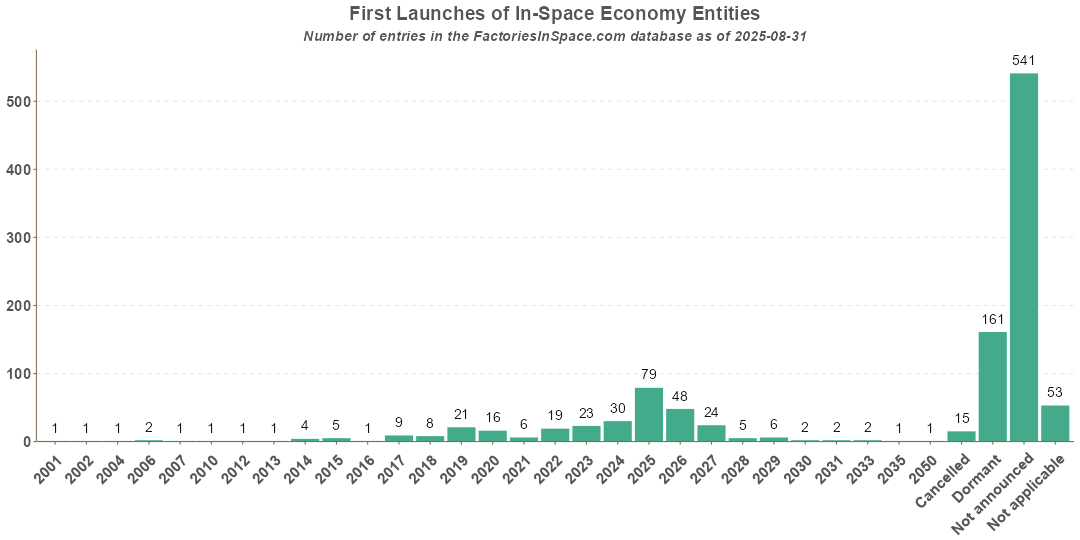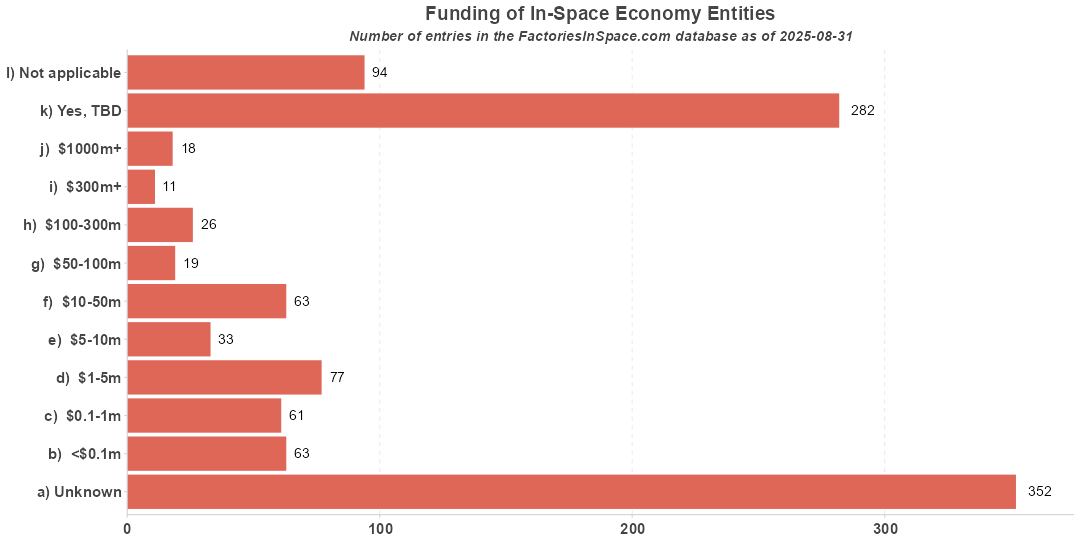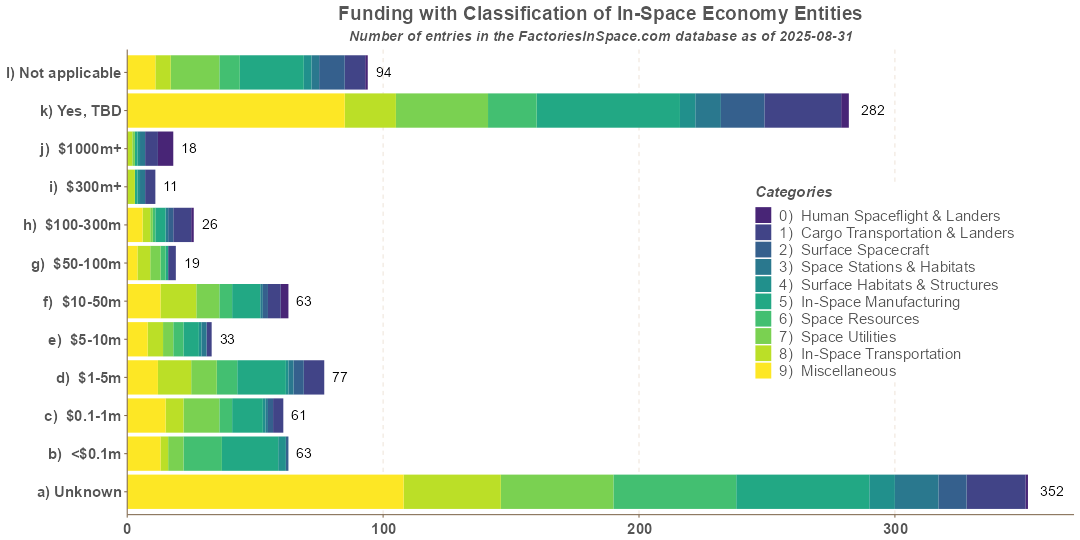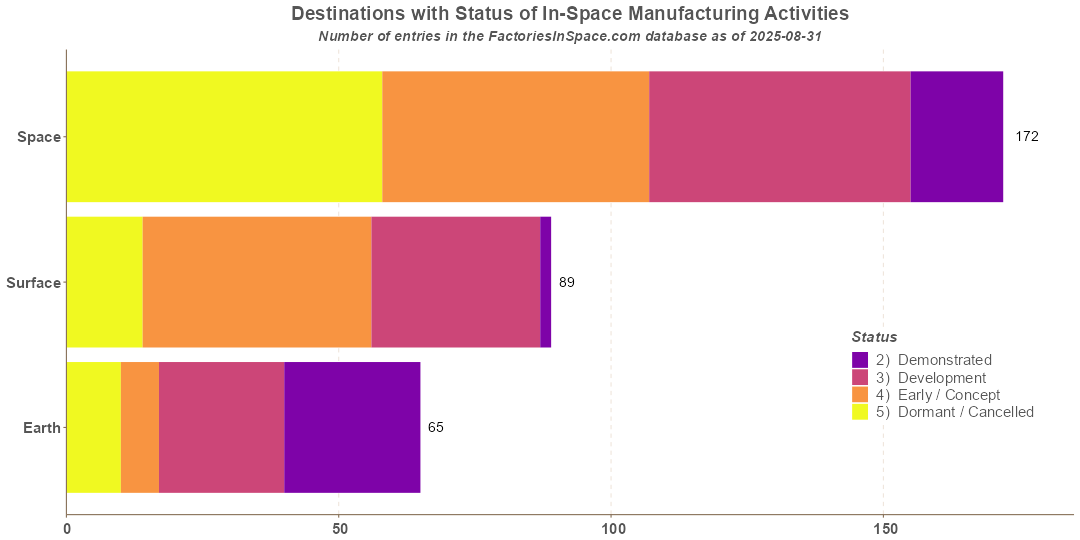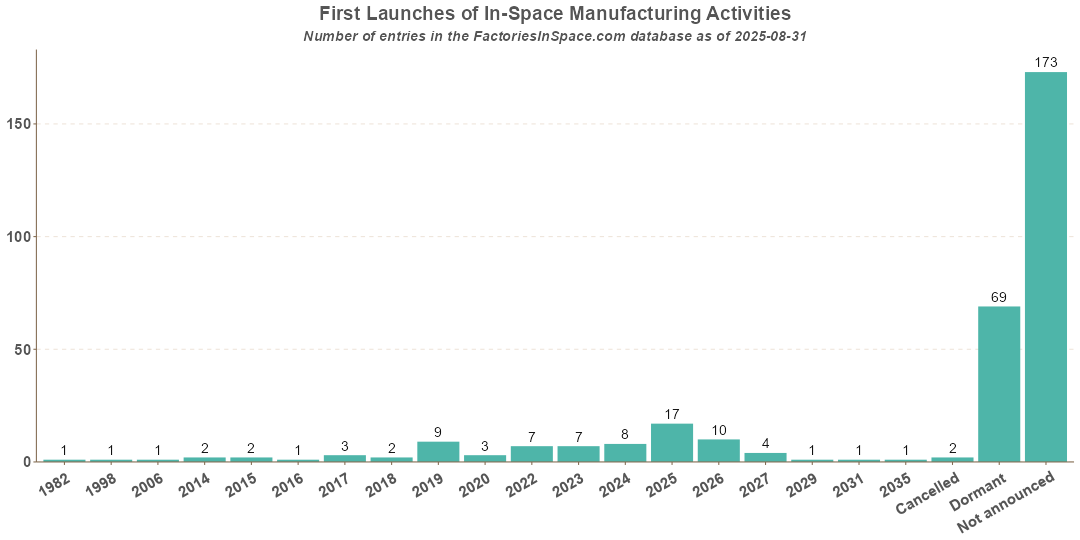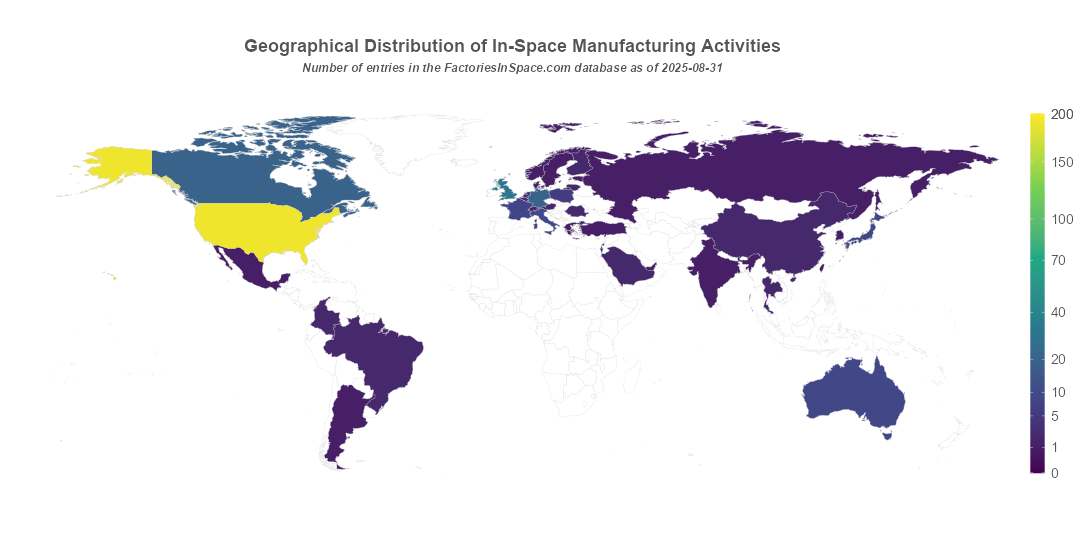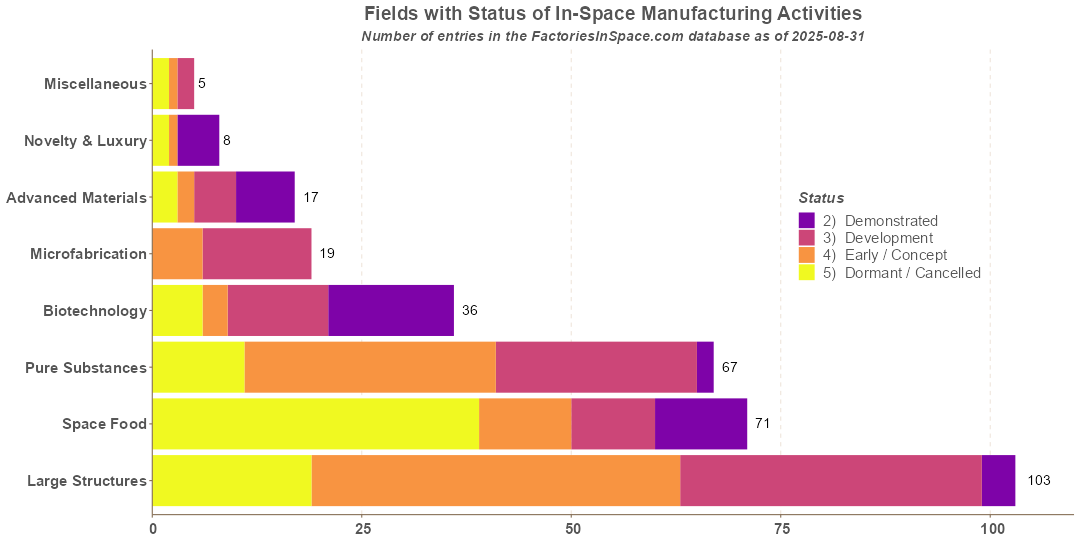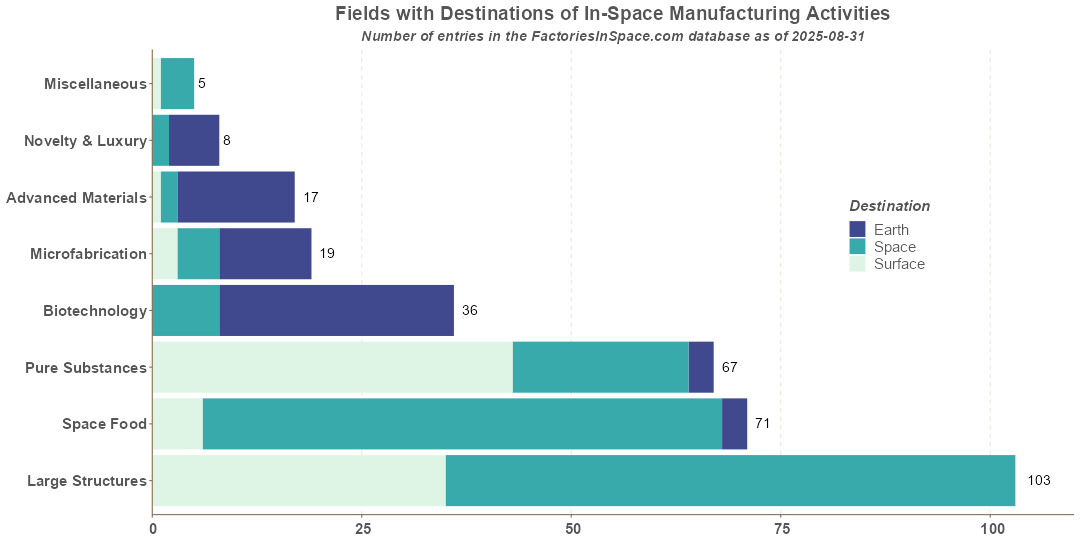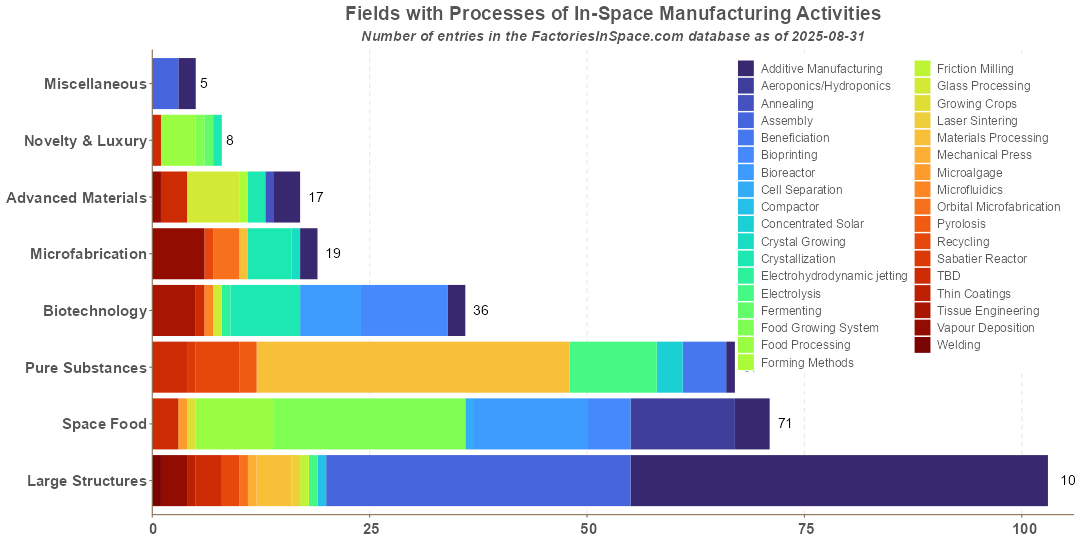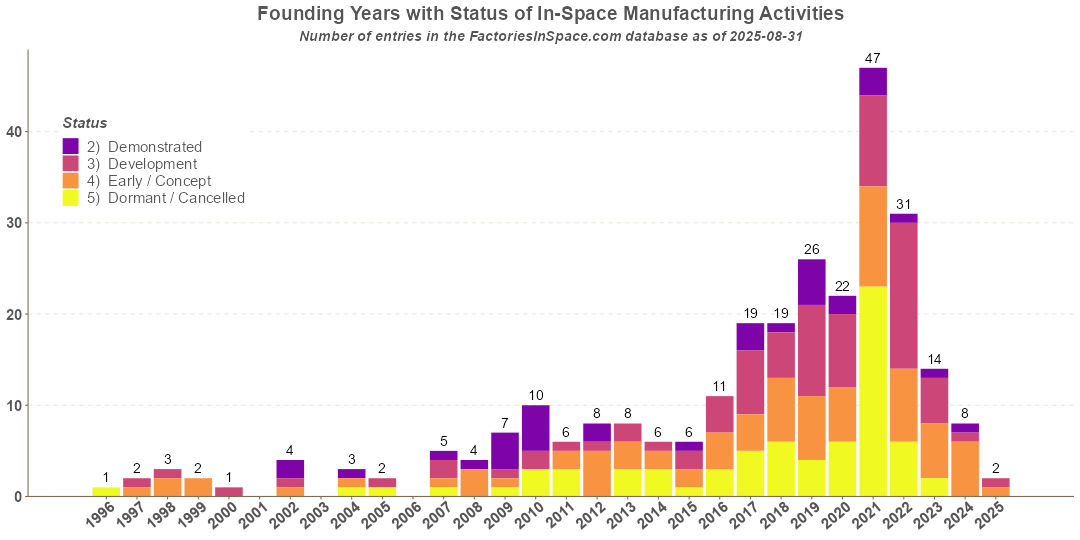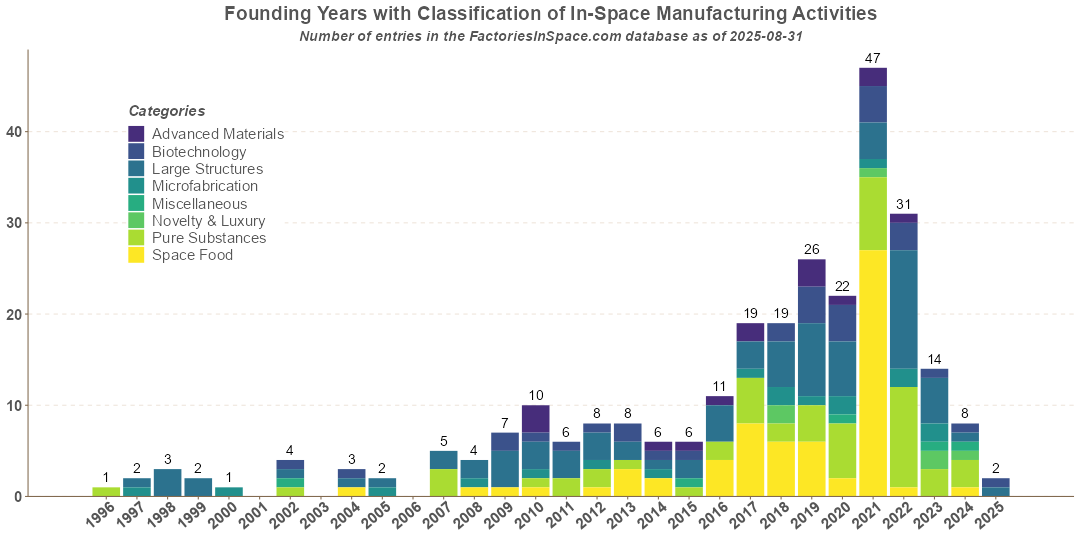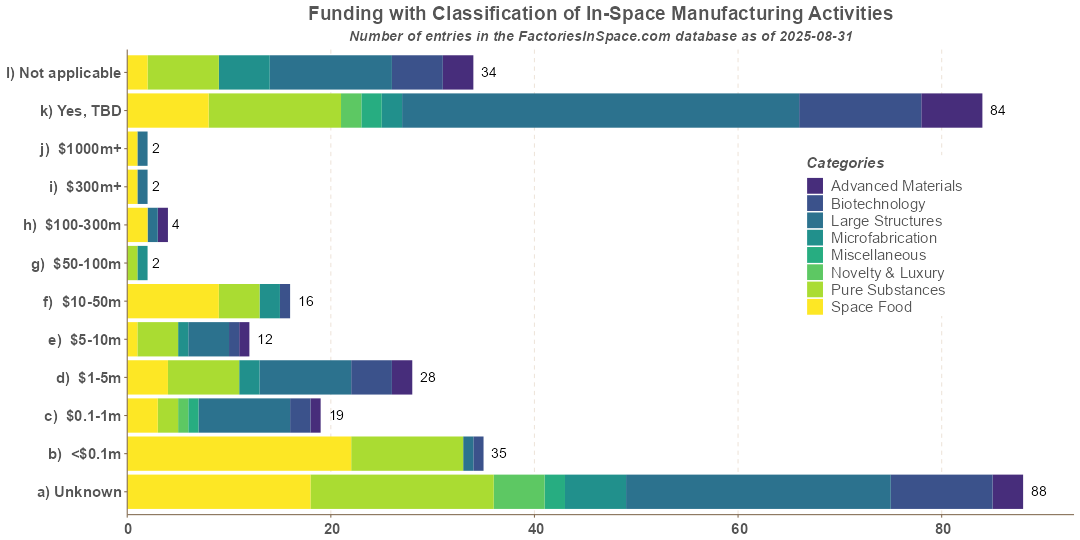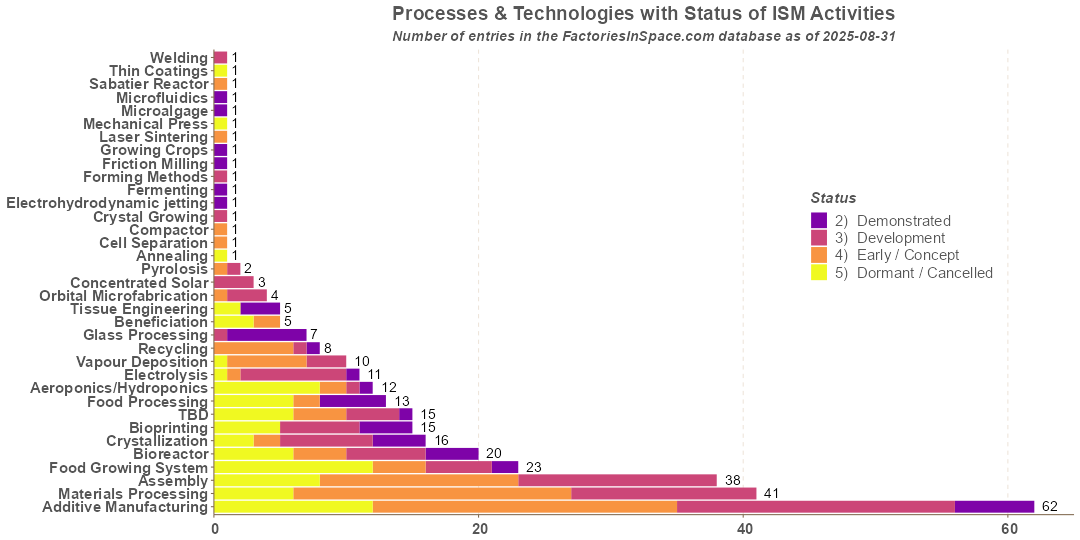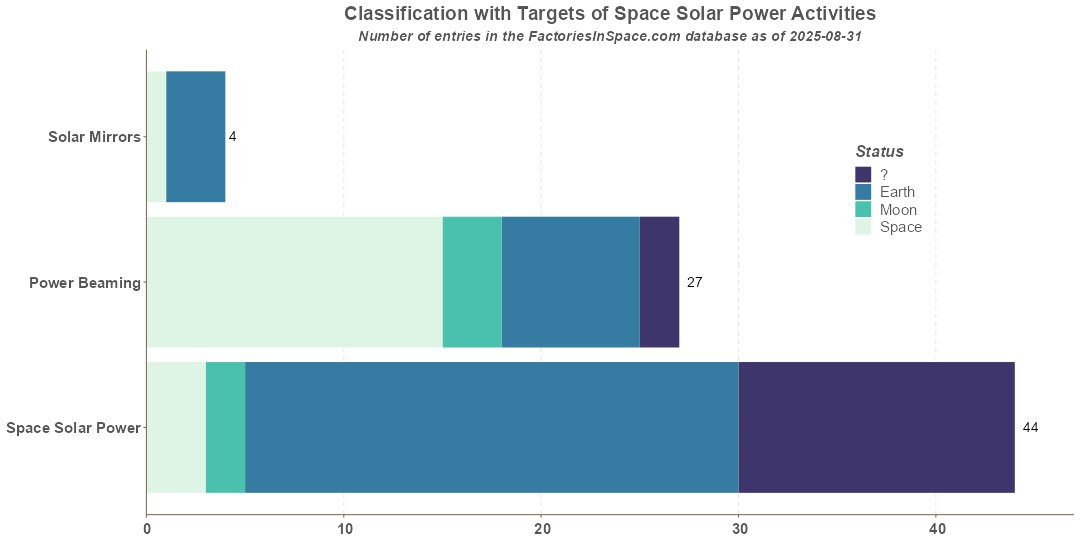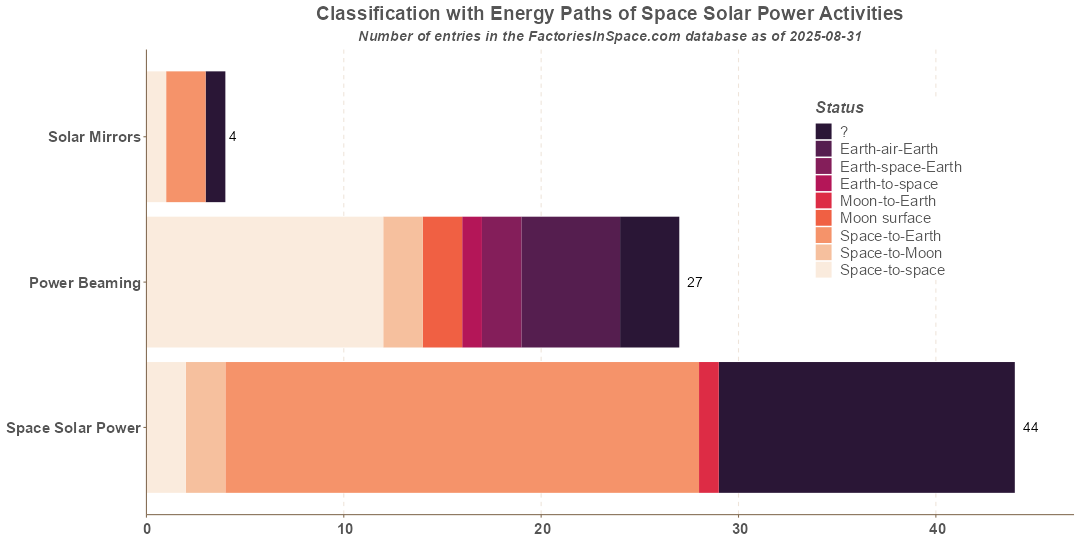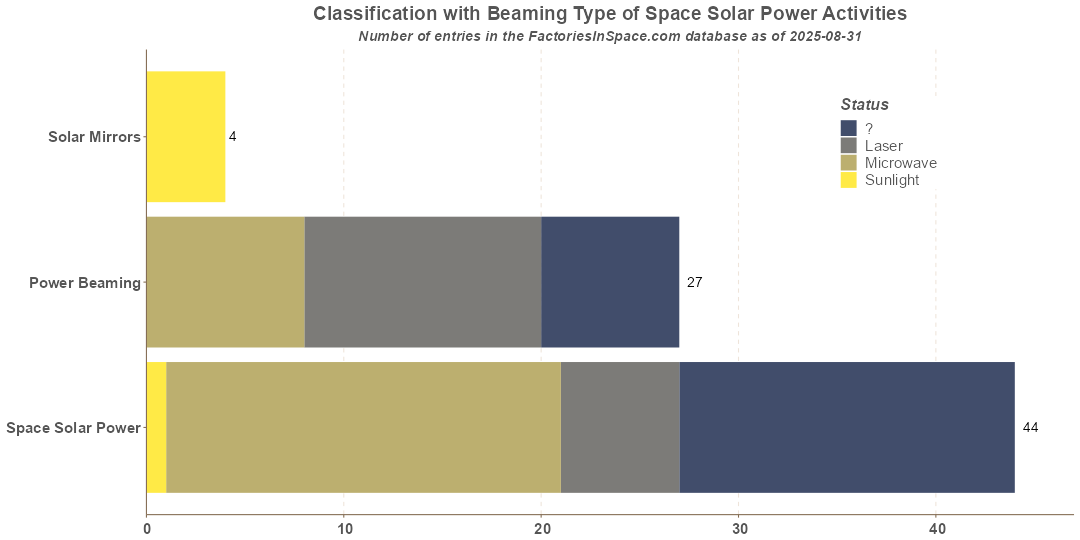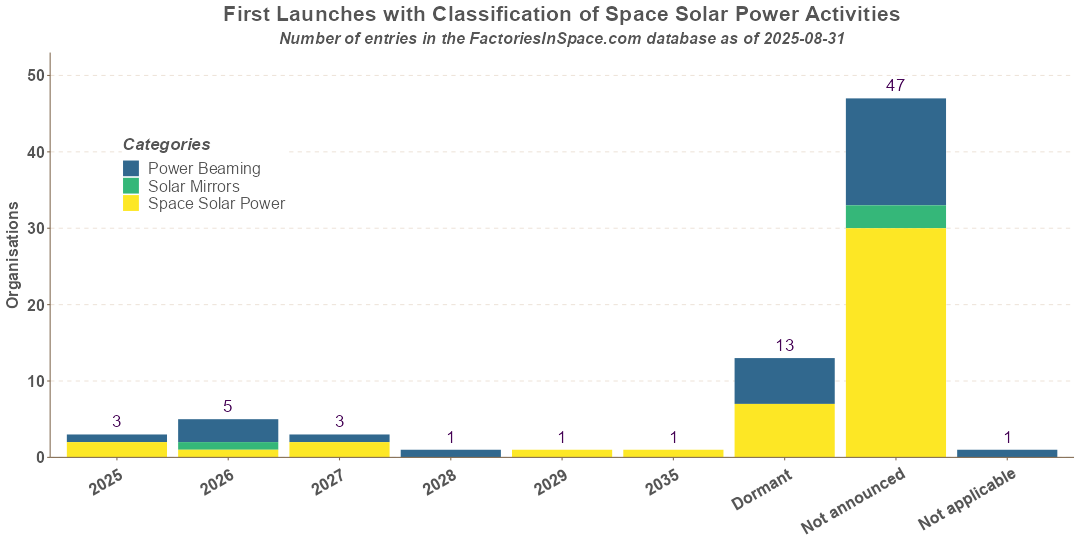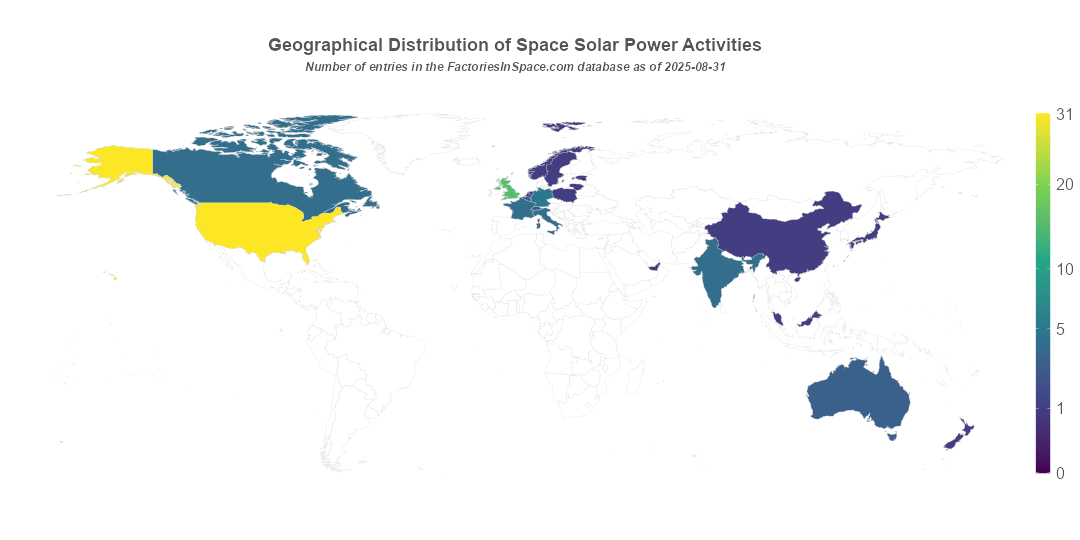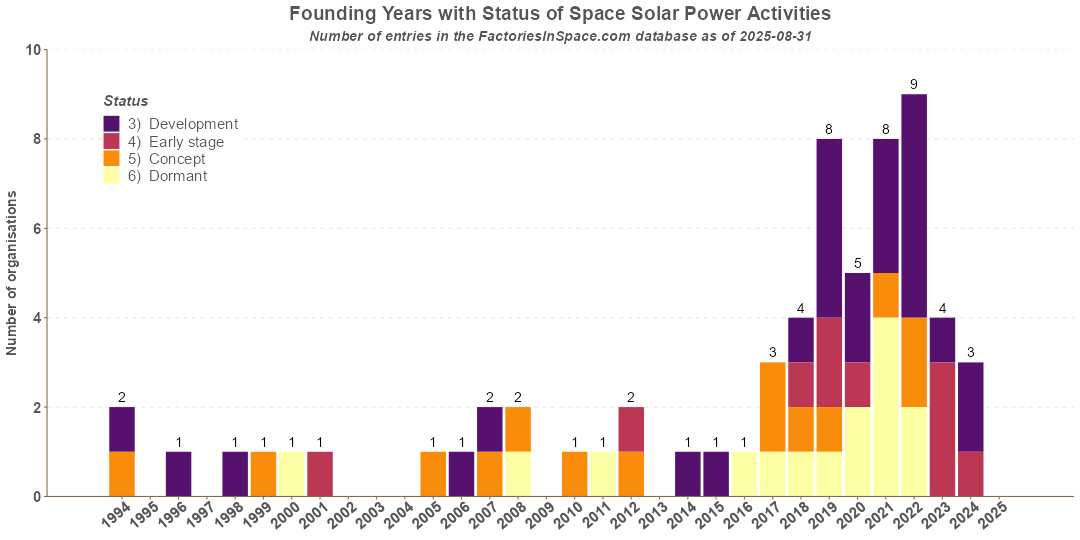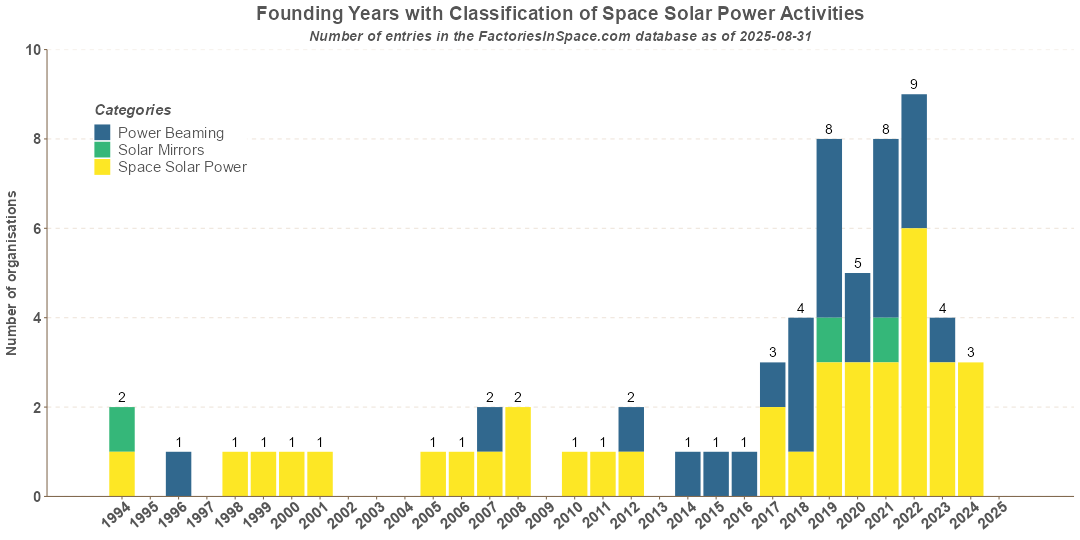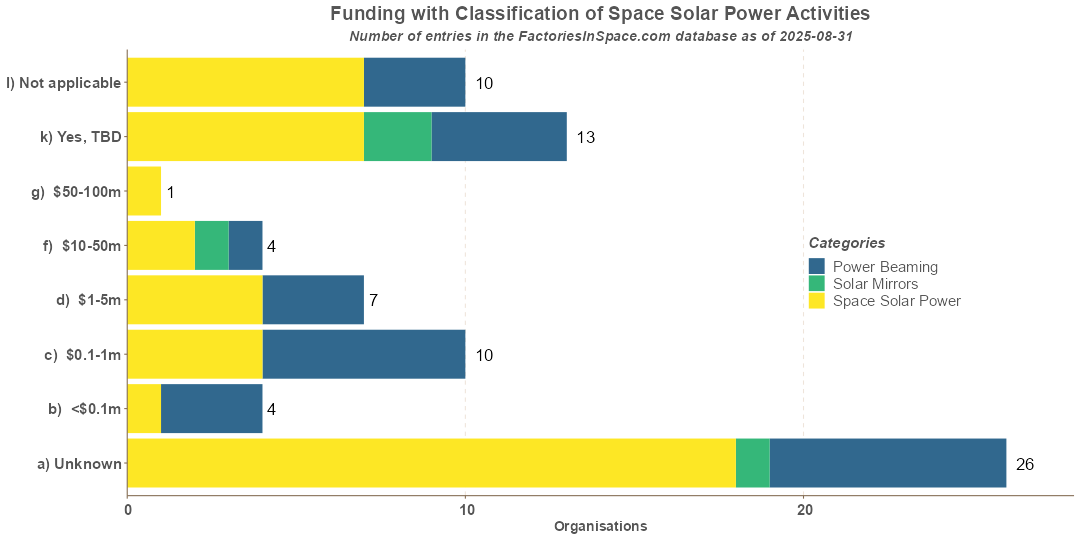Figures about In-Space Economy
Last updated: 2025-08-31
Figures about In-Space Manufacturing (ISM)
Last updated: 2025-08-31
Figures about Space-Based Solar Power (SBSP)
Last updated: 2025-08-31
Taxonomy 1 - Latest In-space economy taxonomy (classification, categories, terminology) used currently for the figures above, latest database and ecosystem map.
| Category | Service | Description |
|---|---|---|
| Human Spaceflight & Landers | Human Spaceflight & Lander | Space vehicles designed for any kind of human flight. Also referred to as crewed spaceflight . It is a separate category due to the level of difficulty, but could be merged in the future. |
| Human Landing Systems | ||
| Human-Rated Landers | Crewed landers and reusable shuttles. | |
| Human-Rated Spaceships & Shuttles | Minimum criteria is an orbital flight in LEO. Includes space transport ships to Moon, Mars and beyond. | |
| Cargo Transportation & Landers | Cargo Transportation & Landers | Spacecraft transporting goods from and to Earth, Moon and Mars. |
| Landers | Commercial robotic landers for Moon, Mars and asteroids. | |
| Cargo Resupply | Space station cargo resupply services. | |
| Reentry Capsules | Dedicated re-entry capsules of which many have been in development and one flown by Russia. This and previous are re-emerging to support in-space manufacturing. | |
| Reusable Spacecraft | Spacecraft with launch and re-entry capability that could be used for orbital activities near Earth and Mars. | |
| Commercial Sample Return | ||
| Microgravity Flight Service (Reusable Satellite) | ||
| Microgravity Flight Service (LEO) | ||
| Surface Spacecraft | Surface Spacecraft | Spacecraft operating on the surface or near the surface of a planetary body. |
| Rovers | Wheeled or rolling robotic vehicles used for exploration, prospecting and transportation. | |
| Drones | Rocket-powered flight on the lunar surface to reach difficult locations or winged and rotary aircraft on Mars, Venus and Titan. | |
| Aircraft | Planes, helicopters and balloons that require atmosphere. For example Mars Helicopter, Ingenuity, but not yet commercial. | |
| Hoppers | Hopping might become a viable transportation method on Moon and asteroids. | |
| Human-Rated Rovers | Sub-set of rovers designed for human use, often larger scale and stricter safety requirements. | |
| Space Stations & Space Habitats | Space Stations & Space Habitats | Free-flying space stations and larger space habitats. Alternatively space platform, orbital colony, space colony and space settlement. They may be located in orbit around the Earth, Moon, Mars, Venus and in Lagrange points. Could be a rotating space station to produce artificial gravity. Merriam-Webster defines a space station as a large artificial satellite designed to be occupied for long periods and to serve as a base [178]. K. Kennedy et al defined space habitats as a recreation of the Earth environment for the purpose of sustaining human life, and that habitats are pressurized crew volumes including laboratories, living quarters, and maintenance facilities [179]. |
| Commercial ISS Airlock | ||
| Commercial ISS Module | ||
| Surface Habitats & Surface Structures | Surface Habitats | alternatively surface facilities. Facilities on the surface of Moon and Mars for habitation, storage and manufacturing. Structures can include physical infrastructure, antennas, telescopes, various plants and factories. |
| Surface Structures | ||
| In-Space Manufacturing | In-Space Manufacturing (ISM) | alternatively off-Earth manufacturing [180] and space-based manufacturing [181]. ISM divides into 2 large areas. First is manufacturing products in microgravity for Earth, which will be brought back for use in terrestrial applications. Second is manufacturing large-scale structures that will remain in space or on the surfaces of planetary objects. |
| In-Space Manufacturing (ISM) | In narrower definition, ISM means making products and materials in microgravity, which cannot be made on Earth, or which have better properties. | |
| In-Space Production | Same as the narrow definition of in-space manufacturing. ISS National Lab has started to use this term [182]. | |
| In-Space Construction | Large-scale construction in space. Alternatively off-world construction. | |
| In-Space Assembly (ISA) | Alternatively in-orbit assembly. A subset of in-space construction, which will likely be the first step before the very large-scale end-to-end construction in space. Xue et al. defines ISA as the assembly activities completed in the target orbit and extraterrestrial space, which is to assemble modules in space in order to form a larger functional element, or to recombine one or more structures after separation [183]. | |
| Microgravity Manufacturing | Alternative name for in-space manufacturing and in-space production. | |
| Space Food, Deep Space Food, Space Farming | Space agriculture will be a large industry to supply fresh food to workers, settlers and tourists, both in space and on Moon, Mars and beyond. | |
| Additive Manufacturing | A subset of in-space construction, also includes 3D printing. | |
| Space Resources | Space Resources | Deals with the prospecting, mining, beneficiation, processing, ISRU and recycling of natural or artificial resources in space, including Moon, Mars and asteroids [1, 184]. |
| ISRU (In Situ Resource Utilization) | Any hardware or operation that harnesses and utilizes ‘in-situ’ resources to create products and services for robotic and human exploration [1]. Encompasses exploration, mine planning, mineral processing, metallurgy and sale of off-Earth resources [1]. | |
| Prospecting | Determining the composition of asteroids, moons and planets with space mining and ISRU as the goal, through the use of remote sensing and in-situ measurements. | |
| Space Mining | Also off-world mining [185] and includes Moon and Mars mining. Extracting and collecting the raw resources from planetoids or planetary surfaces [186]. | |
| Asteroid Mining | Sub-set of space mining focused on asteroids together with basic processing to reduce the mass for transportation. | |
| Lunar Resources | Subset of space resources. | |
| Raw Materials | Processed materials e.g. water, oxygen and metals. | |
| Recycling | Reprocessing artificial objects including satellites and spent rocket stages into raw materials or reusing parts of them. | |
| Processing or Beneficiation | Separating valuable minerals from rock. | |
| Resources - Asteroid Mining | ||
| Asteroid Mining & Processing | ||
| Resources - Energy | ||
| Resources - Metal | ||
| Resources - Oxygen | In-Space Communications Relay | |
| Resources - Hydrogen | ||
| Resources - Space Debris Utilization | ||
| Space Utilities | Space Utilities | alternatively in-space utilities. There will be distinctive supply chains and physical infrastructure for common goods like energy, internet, navigation and water. |
| Energy | Includes space-based solar power, nuclear power and wireless transmission. Electrical energy will likely have a centralized infrastructure on Moon and Mars. Currently served by dedicated solar panels, but solar power stations in space could supply other satellites and vehicles and outposts on the ground. Caltech announced a $100M donation to form the Space-based Solar Power Project [187]. | |
| In-Space Internet | Communications will be a critical infrastructure throughout the solar system and on the surfaces of Moon and Mars. Alternatively in-space data relay, orbital data relay, in-space communications, satellite-to-satellite data relay, interplanetary Internet. | |
| In-Space Communications Relay | ||
| Navigation | Navigation services in space and on Moon and Mars. Possibly required for future landers and surface vehicles. | |
| Water, Propellant | Water in space, and on Moon and Mars, to be used for human consumption, air and propellant. | |
| In-Space Transportation | In-Space Transportation | This could also be called space trucks when compared to utility vehicles. There are many similarities between the following sub-categories because all those spacecraft must be capable of sizeable orbital velocity changes. Due to that the same commercial entities will likely offer multiple services thanks to the common underlying technologies. This would be similar to terrestrial applications, where trucks and pick-ups can serve multiple roles depending on the choice of payload with only small modifications required. A key difference with the Cargo Transportation category is that these vehicles will stay in space and do not have reentry or landing capability. |
| Orbital Transfer Vechicles (OTV) | Spacecraft capable of transporting other spacecraft between different orbits. Capabilities can vary greatly from small altitude and inclination changes to transporting spacecraft from LEO to GEO, Moon, Mars, beyond and everywhere in between. Sometimes also satellite carrier. | |
| Space Tug | Alternative name for orbital transfer vehicles (OTV). | |
| Space Transportation Node | Another name for OTVs. | |
| Propellant Reload Station | Includes propellant refuel stations, propellant depots, orbital refuelling, and propellant tankers [172]. Elon Musk has noted that propellant reloading is a more correct term compared to refuelling because propellant is a combination of fuel and oxidizer [191]. | |
| Active Debris Removal (ADR) | Spacecraft with the means to move near other spacecraft and help them de-orbit faster. For example by grabbing the spacecraft and bringing it to a lower orbit or by attaching a dedicated deorbit module. | |
| On-Orbit Servicing (OOS) | Spacecraft with the means to go nearby other spacecraft and dock with them for propellant loading, orbital repositioning or to stay attached and augment capabilities. J. P. Davis et al. defines OOS as on-orbit activities conducted by a space vehicle that performs up-close inspection of, or results in intentional and beneficial changes to, another resident space object. These activities include non-contact support, orbit modification (relocation) and maintenance, refuelling and commodities replenishment, upgrade, repair, assembly, and debris mitigation [188]. | |
| Space Mobility & Space Logistics | Alternative terms for in-space transportation that has seen some use. AIAA defines space logistics as the science of planning and carrying out the movement of humans and materiel to, from and within space combined with the ability to maintain human and robotics operations within space [192]. | |
| In-Orbit Inspection | Sub-set of on-orbit servicing. Spacecraft capable of travelling nearby to other spacecraft and inspecting them for damages and status. | |
| Satellite Maintenance | Alternative term for in-space servicing [189]. | |
| Orbital Manoeuvring Vehicle | Alternative term space tugs [190]. | |
| Reusable Satellites | Sharing many technologies with OTVs and with spacecraft in general. Uniqueness will be about modular exchangeable payloads that are swapped in space. | |
| Space Mobility, In-Space Logistics | ||
| Transport Service (Earth-LEO) | ||
| 'Transport Service (LEO-GEO) | ||
| Transport Service (LEO-Moon) | ||
| Miscellaneous | Miscellaneous | Supporting and connected products and services to the in-space economy, which largely would not exist without it. Some of them may not strictly generate revenue in space. |
| Space Tourism | Wider terms encompassing human spaceflight and habitation services. Suborbital space tourism companies have been included under Miscellaneous or In-Space Manufacturing. Space tourism is expected to be one customer segment for multiple in-space economy fields in the future. | |
| Surborbital Space Tourism | ||
| Point-to-point | ||
| Space Tourism Support Activities | Space tourists and commercial astronauts will require training and ground support for the foreseeable future. This may include space-themed experiences on Earth. | |
| In-Orbit Data Storage | ||
| In-Orbit Computing | Edge computing and server farms in space. | |
| Commercial Astronauts | Privately employed and trained astronauts to help with commercial activities in space and on surfaces [193, 194]. | |
| Space Situational Awareness | ||
| Space Architecture Office | ||
| Space Traffic Management | Continuous human spaceflight activities between Earth, Moon, Mars and space stations will likely require coordination. This includes Space Situational Awareness (SSA), which 625 US Air Force now calls Space Domain Awareness (SDA) [197]. | |
| Software & Mission Control | ||
| Microgravity Research Payloads | ||
| Microgravity Workspaces | ||
| Space-Data-As-A-Service | ||
| Operations-As-A-Service | ||
| Space Logistics Planning | ||
| Space Entertainment | In-space economy will likely create a new form of entertainment, where the activities will happen in space. Starting with variations of or new types of sports, space casinos, studios, performance shows, and other entertainment activities [195]. | |
| Mission Control | ||
| Space Suits | Spacesuits and space clothing will be required for every astronaut, settler and tourist. | |
| Space Garments | ||
| Space Robotics | Covers for example robotic humanoid astronauts, because other technologies can be categorized under in-space construction, in-space manufacturing, surface spacecraft and servicing. | |
| Space Law | ||
| Space Domain Awareness | ||
| Impactor Probe | ||
| Creative Agency for Space | ||
| Space Advertisements & Marketing | Advertisements in space, on Moon and Mars. For example, Estee Lauder paid NASA $128,000 for a photoshoot of their serum on the ISS [196]. | |
| Moon & Mars Remote Sensing | Imaging in various wavelengths for site selection, cartography and resource mapping. | |
| In-Space Infrastructure | A wider term that would encompass many of the top-level categories like transportation, utilities and stations. No companies in the database have this classification currently and has been only listed for completeness. S. P Sharma and C. Moore define in-Space infrastructure as consisting of the systems and services operating in Earth’s neighbourhood to facilitate commerce, exploration, and scientific discovery [198]. | |
| Parabolic Flight Service | Some microgravity manufacturing can happen during short flights and due to that has been included here for completeness. | |
| Microgravity Flight Service (Suborbital) | ||
| ISS Utilization Service | End-to-end service providers which simplify access to microgravity environment through commercial facilities on the ISS and upcoming space stations, or dedicated free-flyer spacecraft. |
Last updated: 2023-02-26
Taxonomy 2 - Previous In-space economy taxonomy used for the old database subpages.
| Category | Service |
|---|---|
| Manufacturing Companies | In-Space Manufacturing |
| In-Space Assembly | |
| ISRU (In Situ Resource Utilization) | |
| In-Orbit Assembly | |
| In-Space Construction | |
| Surface Habitats | |
| Surface Structures | |
| Deep Space Food (Agriculture) | |
| Additive Manufacturing | |
| Space Robotics | |
| Space Construction Company | |
| Microgravity Services | Commercial Space Station |
| Space Habitat | |
| Space Station | |
| ISS Utilization Service | |
| Commercial ISS Airlock | |
| Commercial ISS Module | |
| Microgravity Flight Service (Reusable Satellite) | |
| Microgravity Flight Service (LEO) | |
| Microgravity Flight Service (Suborbital) | |
| Parabolic Flight Service | |
| Space Resources Services | Resources - Asteroid Mining |
| Resources - Oxygen | |
| Resources - Metal | |
| Resources - Energy | |
| Resources - Hydrogen | |
| Resources - Space Debris Utilization | |
| Raw Materials | |
| Propellant Refuel Station | |
| In-Space Communications Relay | |
| In-Orbit Data Storage | |
| In-Orbit Computing | |
| Deep Space Communications | |
| Space Transport Services | Space Tug |
| Transport Service (Earth-LEO) | |
| Transport Service (LEO-GEO) | |
| Transport Service (LEO-Moon) | |
| Transport Service (Re-Entry) | |
| Commercial Rover | |
| Surface Spacecraft | |
| Human-Rated Rovers | |
| Robotic Drones & Hoppers | |
| Commercial Lunar Rover | |
| Commercial Lunar Lander | |
| Cargo Transport | |
| Active Debris Removal (ADR) | |
| On-Orbit Servicing | |
| Human Landing System | |
| Human Landers | |
| Human Spaceflight | |
| Human Spaceflight & Lander | |
| Human-Rated Spaceships & Shuttles | |
| Commercial Sample Return | |
| In-Space Logistics | |
| Space Transportation Nodes | |
| Orbital Transfer Vechicles (OTV) | |
| In-Orbit Inspection | |
| Miscellaneous | Point-to-point |
| Commercial Astronaut Services | |
| Microgravity Research Payloads | |
| Suborbital Space Tourism | |
| Operations-As-A-Service | |
| Space-Data-As-A-Service | |
| Space Traffic Management | |
| Space Architecture Office | |
| Space Tourism | |
| Space Tourism Support | |
| Microgravity Workspaces | |
| Space Situational Awareness | |
| Software & Mission Control | |
| Space Logistics | |
| Consulting Service | |
| Blog / News | |
| Marketplace / Store | |
| Miscellaneous | |
| Space Entertainment | |
| Space Suits & Garments | |
| Spacesuit | |
| Spaceport Resort | |
| Space Elevator | |
| Space Law | |
| Space Domain Awareness | |
| Impactor Probe | |
| Space Advocacy | |
| Creative Agency for Space |
Last updated: 2022-03-06
Taxonomy 3 - In-Space Manufacturing In-space manufacturing taxonomy used in 2022 for the IAC and NASA papers.
| ISM Category | Description |
|---|---|
| Advanced Materials | Advanced materials made in microgravity have also been called unique materials or exotic materials. They may include ZBLAN and other exotic glasses, superalloys, optical crystals, covetic materials, superconductors, carbon nanotubes, bulk metallic glass and many more. Most preferred and likely the initial market for them could be on Earth thanks to existing industries and supply chains. |
| Biotechnology | Biotechnology field collects potential biomedical in-space manufacturing applications such as medicine, stem cells, tissue engineering, 3D bioprinting, organ growth, pharmaceuticals and many more. |
| Large Structures | Large-scale structures will ultimately enable and lead to the construction of unprecedented space structures and platforms. All areas related to building for space. It can include booms, building materials, additive manufacturing, infrastructure, megastructures, additive construction, in-space construction, in-space assembly, space-based solar power, space stations and many more. |
| Microfabrication | Orbital microfabrication field includes microfabricated goods such as semiconductors, solar cells, thin-films, ultra-thin coatings and many more, which are all microfabrication concepts or processes. Microfabrication is a more general term compared to orbital microfabrication because the manufacturing activity may also happen on planetary surfaces. |
| Novelty & Luxury Goods | Luxury and novelty goods such as jewelry, art, wine, coffee and beer, have started to see an increased traction as space-flown goods. |
| Pure Substances | Pure substances such as water, oxygen, hydrogen, propellants, metals, can also be a result of in-space manufacturing. This was previously called raw materials. These fields are more commonly defined as ISRU, which can still fall under the definition of ISM as fabrication of raw material from mined resources. |
| Space Food | Space food will be a large industry to supply fresh food to workers, settlers and tourists, both in-space and on Moon, Mars and beyond. Other relevant keywords or synonyms are space agriculture, space farming, deep space food, hydroponics, etc. |
Last updated: 2022-10-30
